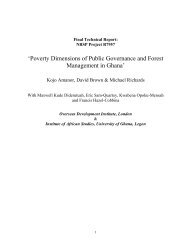Nicola Cantore - Overseas Development Institute
Nicola Cantore - Overseas Development Institute
Nicola Cantore - Overseas Development Institute
Create successful ePaper yourself
Turn your PDF publications into a flip-book with our unique Google optimized e-Paper software.
Scenarios of additional climate<br />
finance<br />
Presenter: Dr <strong>Nicola</strong> <strong>Cantore</strong><br />
Research fellow<br />
<strong>Overseas</strong> <strong>Development</strong> <strong>Institute</strong><br />
n.cantore@odi.org.uk<br />
15/04/2010
Climate finance channels<br />
International public finance<br />
Private capital flows<br />
Domestic climate finance<br />
2
Views on additionality<br />
Complete separation between ODA and climate change<br />
related financing<br />
The amount of climate change related aid that can be<br />
reported as ODA should be limited in order to avoid<br />
diversion from “MDG-related” ODA<br />
All donor support for climate change should be reported<br />
as ODA<br />
All ODA targets and commitments should be adjusted<br />
upwards to take account of climate change financing<br />
needs<br />
3
Climate finance scenarios<br />
BAU Baseline scenarios (BAU)– ODA at 0.7%<br />
of GNI by 2030<br />
ADD1<br />
ADD2<br />
0.7% of GNI climate finance additional to<br />
traditional ODA + 0.5% of GNI. Funding is<br />
counted as ODA and is provided through<br />
similar disbursements mechanisms<br />
0.7% of GNI climate finance additional to<br />
traditional ODA + USD 67 bn. Funding is<br />
counted as ODA and is provided by similar<br />
disbursements mechanisms<br />
DIVERT<br />
ODA at 0.7% of GNI by 2030 but some US<br />
67 billion taken out of aid to spend on<br />
environmental purposes (and not<br />
“traditional” aid)<br />
4
Projections on ODA flows to meet<br />
traditional and climate objectives 2008<br />
US$ billion<br />
ADD1<br />
ODA 0.7% GNP<br />
CF 0.5% GNP<br />
ADD2<br />
ODA 0.7% GNP<br />
CF 67 bn<br />
BAU<br />
ODA<br />
0.7% GDP<br />
DIVERT<br />
Traditional ODA =<br />
0.7% GDP ODA<br />
-US 67 bn on Climate<br />
5
The geographical diversion of<br />
ODA<br />
Aid<br />
Adaptation needs<br />
Sub Saharan Africa 0.38 0.22<br />
South Asia 0.18 0.13<br />
East Europe and Central Asia 0.07 0.12<br />
Middle East and North Africa 0.16 0.05<br />
Latin America and Caribbean 0.08 0.22<br />
East Asia and Pacific 0.13 0.26<br />
Total 1.00 1.00<br />
6
The sectoral diversion of ODA<br />
Sector<br />
2007 ODA gross<br />
disbursements by sector–<br />
USD billion<br />
Additional spending needed<br />
for adaptation in developing<br />
countries (using World Bank<br />
EACC data), USD billion<br />
Agriculture, Forestry, Fisheries 4.1 7.6<br />
Water Supply 3.7 13-17<br />
Human health 6.8 1.2<br />
Economic infrastructure and<br />
services 13.6 13-30<br />
Ecosystem protection 0.4 12-22<br />
7
The recipient`s perspective<br />
Volume of<br />
finance<br />
Sectoral<br />
distribution of<br />
finance<br />
Geographical<br />
distribution of<br />
finance<br />
Quality of<br />
finance<br />
Climate finance<br />
(0.5% of GNI)<br />
additional to aid<br />
(0.7% of GNI)<br />
Aid at 0.7% of GNI<br />
in part diverted to<br />
climate finance<br />
Large additional<br />
volumes<br />
Aid diverted to<br />
climate finance<br />
causes changing<br />
the composition of<br />
finance<br />
Distribution<br />
according to<br />
adaptation needs<br />
would mean scaling<br />
up of support<br />
especially for water,<br />
but less so for<br />
education, health<br />
and aid for trade<br />
Increases in<br />
resources for water,<br />
but cuts for<br />
education, health<br />
and aid for trade<br />
Distribution<br />
according to<br />
adaptation needs<br />
would mean scaling<br />
up of support<br />
especially for Asia,<br />
Latin America and<br />
less to in Africa<br />
Increases in Asia,<br />
Latin America and<br />
Middle East and<br />
cuts in resources<br />
for Africa<br />
Transfers of up to<br />
700 billion to poor<br />
countries may lead<br />
to crowding out<br />
effects and Dutch<br />
disease, without<br />
innovations in<br />
governance to<br />
counteract its<br />
effects<br />
8
The donor`s perspective<br />
Volume of finance<br />
Sectoral<br />
distribution of<br />
finance<br />
Geographical<br />
distribution of<br />
finance<br />
Quality of finance<br />
Climate finance<br />
and aid use same<br />
mechanisms<br />
Difficult to measure<br />
additionality<br />
Donors tend to<br />
emphasise social<br />
sectors rather than<br />
supply side sectors.<br />
Strongly<br />
coordinated, but<br />
issues of speed of<br />
disbursement.<br />
Climate finance<br />
using separate<br />
channels<br />
involving public<br />
transfers<br />
Easy to measure<br />
additionality<br />
compared to<br />
existing aid.<br />
Mechanisms<br />
earmarked for<br />
certain sectors<br />
Fragmentation in<br />
development<br />
assistance and<br />
increase in<br />
transaction costs<br />
Climate finance<br />
through private<br />
channels<br />
Easy to measure<br />
additionality, but<br />
risks in reaching<br />
required aid<br />
volumes when<br />
relying on markets<br />
(e.g. carbon price).<br />
Relative increase in<br />
resources in those<br />
sectors more ready<br />
for private<br />
ownership and<br />
transfers<br />
Relative increases<br />
in resources in<br />
those countries with<br />
better prospects for<br />
investment (e.g. not<br />
in poor countries in<br />
Africa)<br />
Potential issues of<br />
alignment with<br />
public sector<br />
funding, but private<br />
finance may have<br />
larger development<br />
externalities<br />
9
Conclusions<br />
Current ODA spending may not cover<br />
future adaptation needs<br />
If current ODA spending level is used<br />
to cover adaption needs there is a<br />
concrete risk of geographical and<br />
sectoral funds diversion.<br />
10
Thanks for the attention!!!<br />
11

















